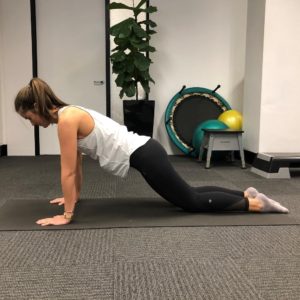In this blog we are going to add another exercise to the ‘Reformer Pilates vs Mat exercise’ blog series. This blog will talk about how “planks” can be done on both the mat and on the reformer. Along with the different stability challenges associated with each.
As with any planks there are different variations you can add to the exercise to make it more or less challenging. I will give you a few different variations of these throughout the blog. Planks in general can be a tough exercise so if you have any lower back, abdominal separation or shoulder issues, I would consult with one of our Physios before adding this into your exercise regime.
Mat:
When planking on the mat we generally start on your knees and then progress onto your toes. You can also do a plank on either your hands (high plank) or forearms (low plank). Generally, a low plank loads through your shoulder more. To ensure you have good activation across your deep abdominals, try pulling your hipbones together as if you are tightening an imaginary belt. This is only a light contraction and shouldn’t involve sucking in your belly. When doing a plank on the mat it is less of a stability challenge than the reformer. This is because you have a stable base of support on the mat.
Reformer:
Planks on the reformer are similar to the mat plank in that they can be done both on your forearms or hands and on your knees or toes. Same as with the mat exercise, you should start on your knees as this is easier than a full plank. As mentioned above, the reformer adds an extra stability challenge because of the spring resistance. The lighter the spring is, the more challenging the exercise is for your abdominals. If the spring is heavier this will load through your upper body and shoulders and give more support for your abdominals.
Knees (less challenging)
Mountain climbers (Single leg knee to chest)
Knee tucks (Both knees to chest of the reformer)
Hip lifts (Keeping legs straight and lifting hips up to the ceiling)
Side planks (weight through one arm, holding body side on)
This is just one example of an exercise which can be done on both the mat and reformer. Keep a look out on the Bend and Mend blog page to see some more mat vs reformer exercises.
If you would like a personalised Physiotherapy-led exercise program using Pilates equipment come in for an assessment with one of our Bend + Mend Physios today.








